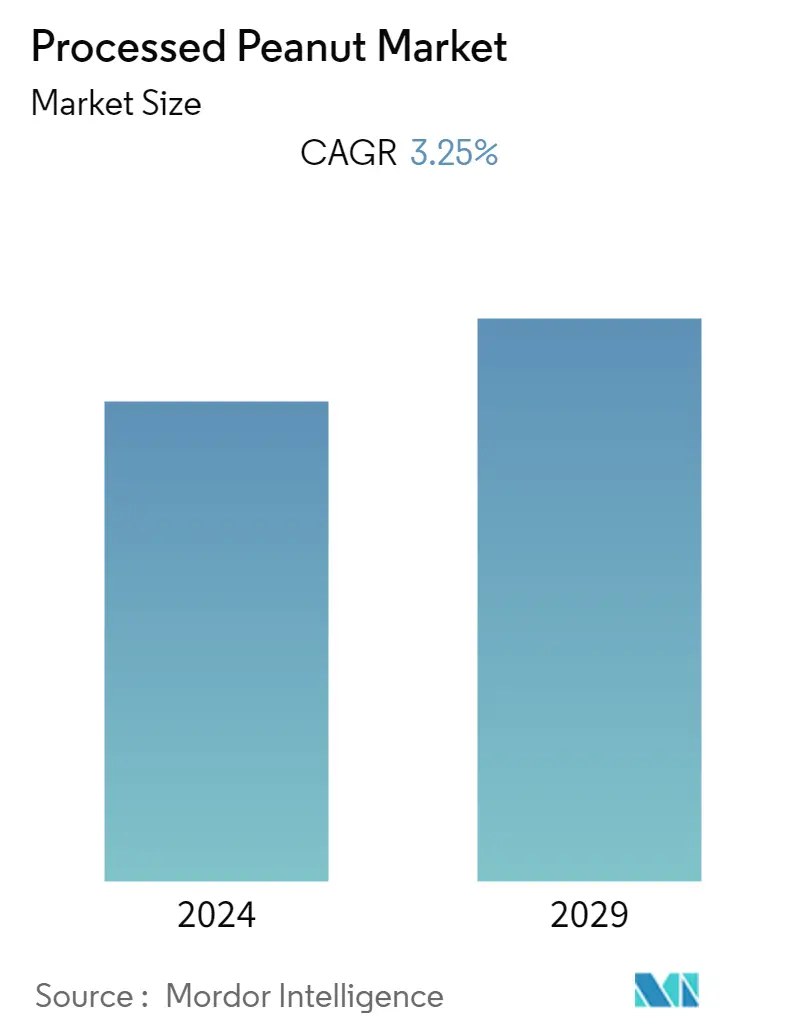Market Size of Processed Peanut Industry

| Study Period | 2019 - 2029 |
| Base Year For Estimation | 2023 |
| CAGR | 3.25 % |
| Fastest Growing Market | North America |
| Largest Market | Asia-Pacific |
| Market Concentration | Low |
Major Players
*Disclaimer: Major Players sorted in no particular order |
Processed Peanut Market Analysis
The processed Peanut Market is projected to register a CAGR of 3.25% during the forecast period, 2022-2027.
The market is majorly driven by the growing awareness of the health benefits of peanuts as they are rich sources of fiber, protein, vitamins, antioxidants, and other essential minerals, and increasingly getting their popularity in the paleo diet. Additionally, the growing vegan population across the world is also supporting the growth of the market as peanuts are broadly considered a good alternative for fish and eggs for fulfilling protein, calcium, and vitamin B12 daily requirement. In recent decades, peanuts have gained an excellent reputation for being a health nut, as most of the fats they contain are known as 'good fats.' These kinds of fats help lower cholesterol levels in the body. Peanuts help prevent heart disease by lowering cholesterol levels. They can also prevent the formation of small blood clots and reduce the risk of having a heart attack or stroke.
Moreover, another advantage of peanuts is that they are more reasonably priced than many other types of nuts. Due to cost-benefit considerations and concerns of running out of things, the majority of consumers opt for bulk purchasing peanuts. Thus, large basket sizes remained a significant reason for the substantial sales of peanuts across all regions. In the medium term, the market is anticipated to witness the expansion of flavored peanut offerings by leading brands. For example, in June 2022, Planters, a Hormel Foods Corp. brand, launched Sweet & Spicy Dry Roasted Peanuts, which are now available at convenience stores.
Processed Peanut Industry Segmentation
Processed peanuts refer to raw peanuts without shells and other packaged peanut snacks such as roasted peanuts and flavored peanuts. The processed peanut market is segmented by type, distribution channel, and geography. By type, the market is segmented into plain peanuts and flavored peanuts. By flavored, the market is further classified as salted, sweet flavored, spicy flavored, and others. By distribution channel, the market is segmented as supermarkets and hypermarkets, convenience stores, online stores, and other distribution channels. It provides an analysis of emerging and established economies across the world, comprising North America, Europe, South America, Asia-Pacific, and Middle-East & Africa. For each segment, the market sizing and forecasts have been done on the basis of value (in USD million).
| By Type | ||||||
| Plain | ||||||
|
| By Distibution Channel | |
| Supermarkets/Hypermarkets | |
| Convenience Stores | |
| Online Stores | |
| Other Distribution Channels |
| By Geography | |||||||||
| |||||||||
| |||||||||
| |||||||||
| |||||||||
|
Processed Peanut Market Size Summary
The processed peanut market is experiencing growth driven by increasing awareness of the health benefits associated with peanuts, such as their high content of fiber, protein, vitamins, and antioxidants. This trend is further supported by the rising vegan population, as peanuts serve as a viable alternative for protein and essential nutrients typically found in animal products. The market is also benefiting from the popularity of peanuts in paleo diets and their reputation as a source of 'good fats' that can help lower cholesterol and reduce the risk of heart disease. Additionally, the cost-effectiveness of peanuts compared to other nuts encourages bulk purchasing, contributing to substantial sales across various regions. The demand for convenient and healthy on-the-go snacks is also boosting the market, with manufacturers offering portable packaging options to cater to busy consumers.
The global processed peanut market is characterized by its fragmented and competitive nature, particularly in developed regions with numerous snack food manufacturers. Key players are focusing on product innovation, attractive packaging, and omnichannel distribution to meet consumer demand and gain a competitive edge. The market is further propelled by the availability of flavored peanut offerings and the growing interest in plant-based proteins. The high production of peanuts in countries like China, India, and the United States ensures a steady supply of raw materials for processed peanut snacks. As consumer preferences shift towards healthy snacking and convenience foods, the market is expected to continue its growth trajectory, supported by the introduction of new flavors and strategic partnerships by leading brands.
Processed Peanut Market Size - Table of Contents
-
1. MARKET DYNAMICS
-
1.1 Market Drivers
-
1.2 Market Restraints
-
1.3 Porter's Five Force Analysis
-
1.3.1 Threat of New Entrants
-
1.3.2 Bargaining Power of Buyers/Consumers
-
1.3.3 Bargaining Power of Suppliers
-
1.3.4 Threat of Substitute Products
-
1.3.5 Intensity of Competitive Rivalry
-
-
-
2. MARKET SEGMENTATION
-
2.1 By Type
-
2.1.1 Plain
-
2.1.2 Flavored
-
2.1.2.1 Salted
-
2.1.2.2 Sweet Flavored
-
2.1.2.3 Spicy Flavored
-
2.1.2.4 Others
-
-
-
2.2 By Distibution Channel
-
2.2.1 Supermarkets/Hypermarkets
-
2.2.2 Convenience Stores
-
2.2.3 Online Stores
-
2.2.4 Other Distribution Channels
-
-
2.3 By Geography
-
2.3.1 North America
-
2.3.1.1 United States
-
2.3.1.2 Canada
-
2.3.1.3 Mexico
-
2.3.1.4 Rest of North America
-
-
2.3.2 Europe
-
2.3.2.1 United Kingdom
-
2.3.2.2 Germany
-
2.3.2.3 Spain
-
2.3.2.4 France
-
2.3.2.5 Italy
-
2.3.2.6 Russia
-
2.3.2.7 Rest of Europe
-
-
2.3.3 Asia-Pacific
-
2.3.3.1 China
-
2.3.3.2 Japan
-
2.3.3.3 India
-
2.3.3.4 Australia
-
2.3.3.5 Rest of Asia-Pacific
-
-
2.3.4 South America
-
2.3.4.1 Brazil
-
2.3.4.2 Argentina
-
2.3.4.3 Rest of South America
-
-
2.3.5 Middle East & Africa
-
2.3.5.1 Saudi Arabia
-
2.3.5.2 South Africa
-
2.3.5.3 Rest of Middle East & Africa
-
-
-
Processed Peanut Market Size FAQs
What is the current Processed Peanut Market size?
The Processed Peanut Market is projected to register a CAGR of 3.25% during the forecast period (2024-2029)
Who are the key players in Processed Peanut Market?
Hormel Foods, LLC, John B. Sanfilippo & Son, Inc. , Whitley's Peanut Factory., Frito-Lay North America, Inc. (PepsiCo) and The Peanut Shop of Williamsburg. are the major companies operating in the Processed Peanut Market.

